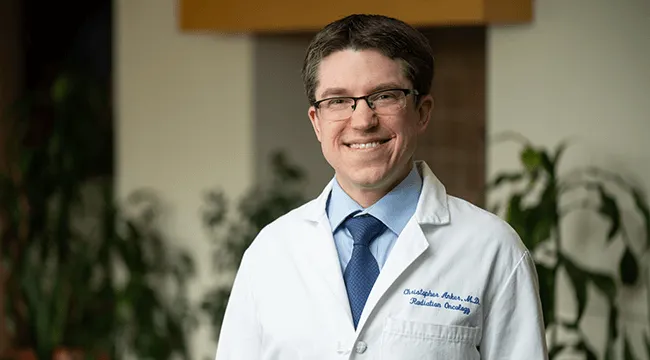Cancer Center’s Chris Anker, M.D., on New Treatment Guidelines for Rectal Cancer
We sat down with Chris Anker, M.D., a professor of radiation-oncology specializing in colorectal cancer and co-leader of the UVM Cancer Center’s Cancer Host and Environment Research Program, which explores the relationship between cancers and their host environments. In November 2024, Anker—supported by UVM colleagues Dmitriy Akselrod, M.D., associate professor of radiology, and Peter Cataldo, M.D., professor of surgery—led a study on treatments for rectal cancer that has since influenced new national guidelines for rectal cancer treatment focusing on quality of life.
Let’s talk about the study, published in the International Journal of Radiation Oncology, Biology, Physics, which influenced new guidelines for the treatment of rectal cancer. What about these guidelines is different from the old guidelines?
CA: For decades, we’ve involved surgery as part of the standard of care for rectal cancer; for more advanced cases, it’s been a cornerstone of management alongside chemotherapy and radiation. But what these new guidelines aim to do is encourage people to recognize the quality-of-life benefits with either avoiding radiation therapy for some patients, or surgery for a broader range of patients. The real difference is highlighting and trying to guide providers toward understanding the excellent outcomes with these more quality of life–focused therapies, and also showing providers how to bring these options to their practice.
What do you mean by “quality of life”? And how might these new guidelines impact a patient’s quality of life?
CA: “Quality of life” can mean a broad range of things. Traditionally, we might define quality of life as fewer side effects from treatment, including those impacting bowel function and sexual function. What’s borne out in the literature, however, is that patients just want to keep doing the things they like to do every day, whether it’s going for a walk or a kayak ride for a couple hours and not having to worry about running to a bathroom or being uncomfortable while doing those things. And there’s a better chance of being able to continue on as you were in your life if you avoid unnecessary therapies. So, the guidelines really focus on patients only needing one local therapy, which is typically combined with chemotherapy for their cancer, whether it’s radiation or surgery.
In terms of the effect these guidelines might have on rural patients: For those who don’t need radiation at all, the number of overall visits decreases because you don’t need to come in for what has been traditionally five to six weeks of radiation therapy; however, these guidelines do allow for some flexibility in the radiation regimens, and some patients may be eligible for just five days of radiation. For those who avoid surgery, they don’t need to interrupt their lives for the procedure and recovery time. This is important for providers, patients, and their caregivers, as they decide what might work best for the patient while allowing space for those more convenient options.
What was your process for determining these new guidelines?
CA: Guideline documents such as the ones we worked on don’t just evaluate the first few papers that come up in a Google search or research database; they look at all the evidence. So, while an individual doctor might not have time to look through thousands of articles to pick out the best studies, we as researchers will actually do that in what is called a “systematic review.” We go through thousands of references to distill only the best information out there into the framework for developing these guidelines.
We work with a panel of multidisciplinary providers who are experts in their field—medical oncologists, surgeons, radiation oncologists, radiologists—to analyze the literature, and we come up with practical, common cases that pertain to almost any rectal cancer patient going to their doctor. These guidelines highlight all the options that are supported by evidence, so providers can have more meaningful conversations with their patients about next steps.
Personally, I think cancer care is at its best when you can provide a menu of options for patients. There’s not a one-size-fits-all therapy, and the patient deserves to know their range of options so they can make the choice that’s best for them.
So much has changed in the last few years to improve quality of life for patients. Where do you see science going in the next 5 to 10 years?
CA: The advances that I see happening are giving us a better understanding of who may be at risk for colorectal cancer, and I expect that our ability to identify patients who are at risk and who may need more aggressive screening based on their family history and other factors will continue to improve. After all, the best way to preserve that quality of life is to never get cancer in the first place.
If you are due for a colorectal cancer screening, it’s always recommended to talk to your primary care provider about the option that’s best for you. Screening allows for early detection, decreases treatment time, and increases survival for those who do have the disease.
